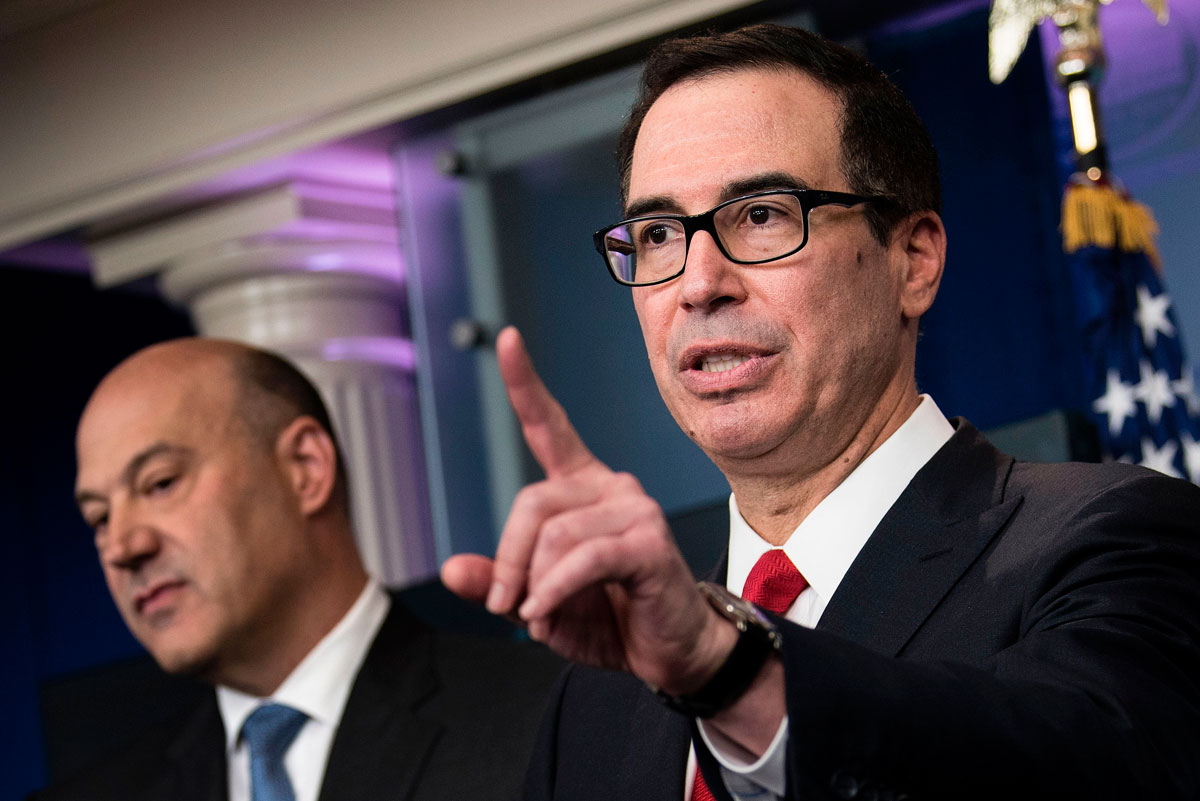Trump Announces One of the Biggest Tax Cuts in U.S. History
National Economic Council Director Gary Cohn (l) and U.S. Secretary of the Treasury Steven Mnuchin take questions on tax cuts and reform during a briefing at the White House, April 26, in Washington, D.C. (Brendan Smialowski/AFP/Getty Images)
@Siliconeer #Siliconeer #DonaldTrump #USCongress @TiESV #TiESV #IndianAmerican #USTaxes #Taxcuts #SiliconValley #Community – The Trump administration announced, April 26, what it claimed to be “one of the biggest tax cuts in American history,” through drastically reducing tax rates both in the business and individual categories, fulfilling one of its major election promises, writes Lalit K. Jha.
The new tax proposal proposes to bring down the corporate tax from the current 35 percent to 15 percent, significantly lower individual tax rates, and eliminate several tax rates like the death tax.
This would “unlock” the U.S. economy, give a big boost to businesses, create jobs and bring trillions of dollars stacked overseas by its companies, U.S. Treasury Secretary Steven Mnuchin told reporters at a joint White House News conference with the National Economic Director Gary Cohen.
“This tax reform package is about economic growth and creating jobs,” Cohen said as he and Mnuchin outlined the growth of the tax cuts announced by the Trump administration.
“Today we are putting out the core principles,” Mnuchin said.
For individuals, the Trump administration proposes to reduce the existing seven tax brackets to three tax brackets of 10%, 25% and 35%; doubling the standard deduction and provide tax relief for families with child and dependent care expenses.
It simplifies to eliminate targeted tax breaks that mainly benefit the wealthiest taxpayers, protects the home ownership and charitable gift tax deductions, repeals the Alternative Minimum Tax, repeal the death tax and repeals the 3.8% Obamacare tax that hits small businesses and investment income.
In addition to a flat 15% business tax rate, the Trump administration proposed territorial tax system to level the playing field for American companies, one-time tax on trillions of dollars held overseas and eliminate tax breaks for special interests.
Throughout the month of May, the Trump administration will hold listening sessions with stakeholders to receive their input and will continue working with the House and Senate to develop the details of a plan that provides massive tax relief, creates jobs and makes America more competitive and can pass both chambers.
“We are going to double the standard deduction, so that a married couple won’t pay any taxes on the first $24,000 of income they earn. So, in essence, we are creating a zero tax rate for the first $24,000 that a couple earns,” Gary said.
“The larger standard deduction also leads to simplification because far fewer taxpayers will need to itemize, which means their tax form can go back to that one simple page that I talked about earlier. Families in this country will also benefit from tax relief to help them with child and dependent care expenses,” he said.
Mnuchin said the objective is to make U.S. businesses the most competitive in the world.
“Right now we have a 35 percent corporate rate on worldwide income in deferral. It is perhaps the most complicated and uncompetitive business rate in the world. Not a surprise that companies leave trillions of dollars offshore,” he said.
“Under the Trump plan, we will have a massive tax cut for businesses and massive tax reform in simplification. As the president (Donald Trump) said during the campaign, we will lower the business rate to 15%; we will make it a territorial system; we will have a one-time tax on overseas profits, which will bring back trillions of dollars that are offshore to be invested here in the U.S., to purchase capital and to create jobs,” Mnuchin said.
Asserting that the president is determined to unleash economic growth for businesses, the treasury secretary said this is not just about large corporations.
Small and medium-size businesses will be eligible for the business rate as well, Mnuchin added.


